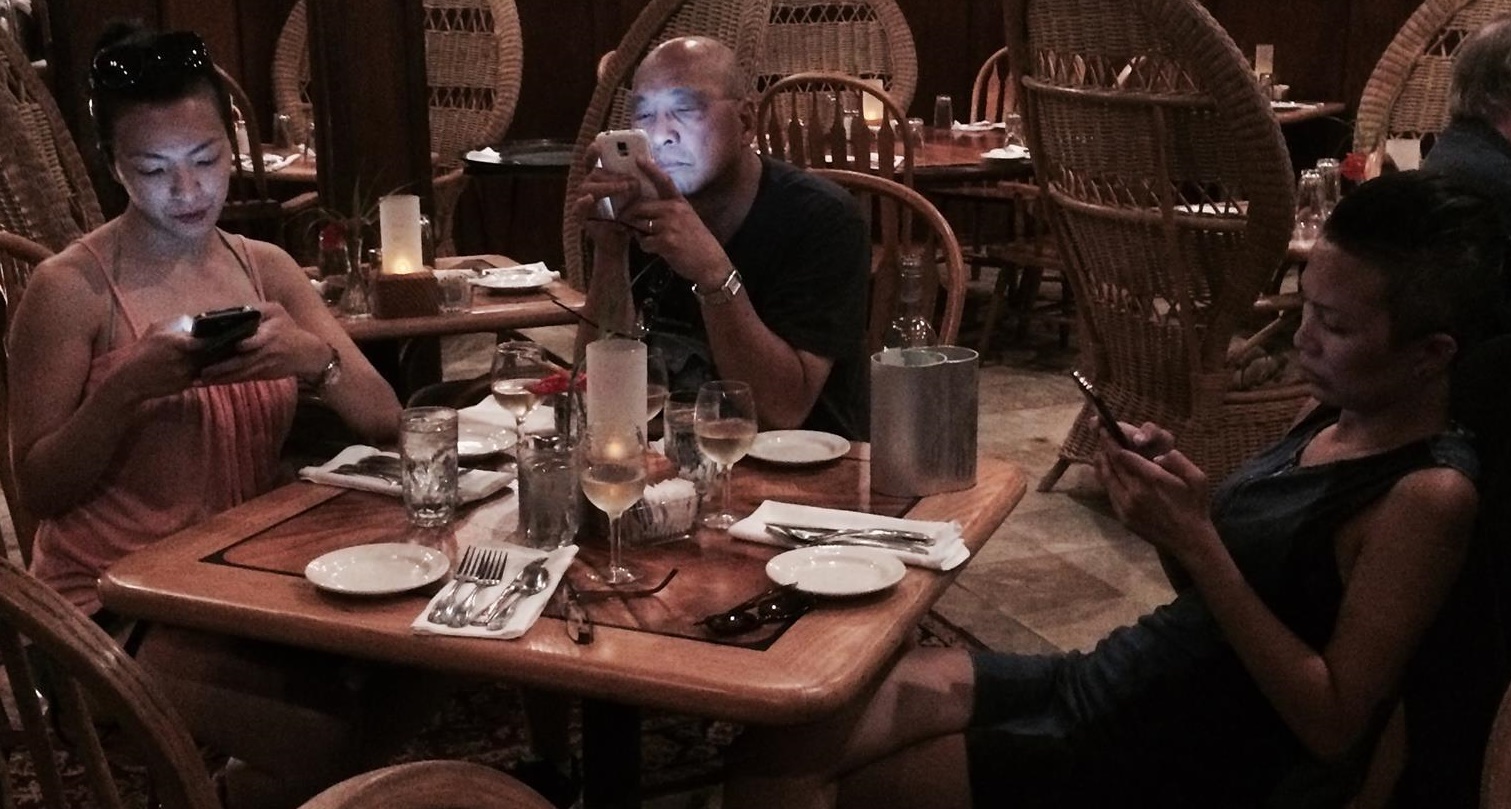Betcha can’t guess how much Malaysia spends on Internetz ads
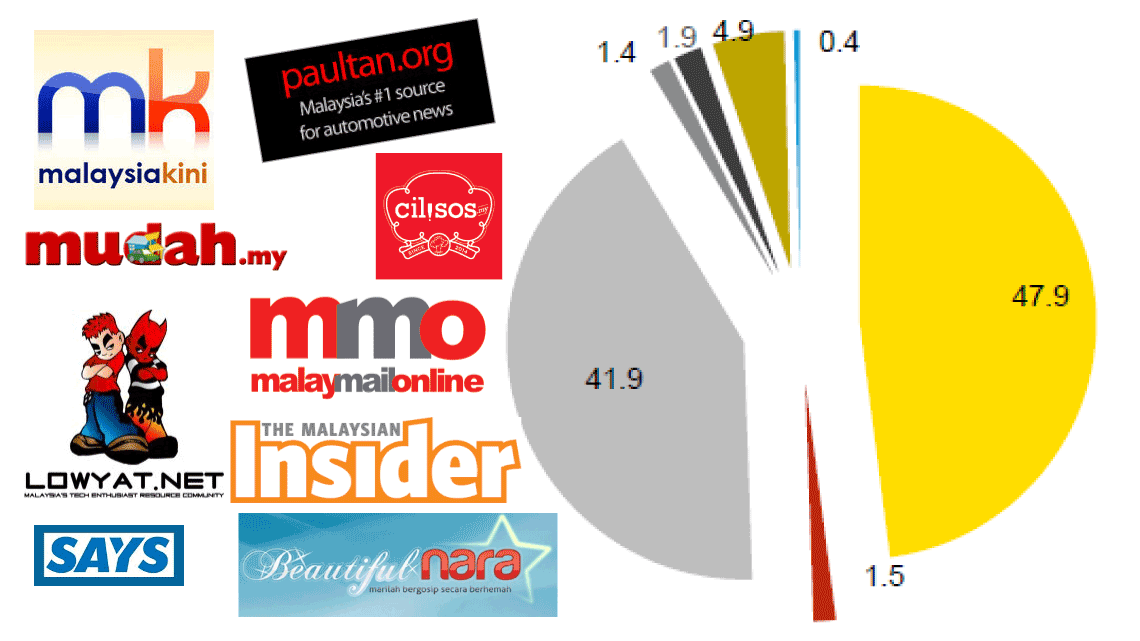
- 564Shares
- Facebook542
- LinkedIn1
- WhatsApp1
 In the last two weeks, we’ve heard news of BusinessInsider.my, Clive, Fairways, Mint closing down. These were all owned by the publisher of SAYS.COM, Rev Asia. In other news, teen mag Seventeen Malaysia and Chinese women’s mag Jessica Malaysia are also closing down. In other news, Yahoo! has cut its entire Malaysian editorial department (incidentally, Yahoo! syndicates content from CILISOS LEGALLY peepur!) and Bernama TV can’t afford to pay its staff.
In the last two weeks, we’ve heard news of BusinessInsider.my, Clive, Fairways, Mint closing down. These were all owned by the publisher of SAYS.COM, Rev Asia. In other news, teen mag Seventeen Malaysia and Chinese women’s mag Jessica Malaysia are also closing down. In other news, Yahoo! has cut its entire Malaysian editorial department (incidentally, Yahoo! syndicates content from CILISOS LEGALLY peepur!) and Bernama TV can’t afford to pay its staff.
It’s a lot of retrenchment in a very short span of time. And it’s websites, AND magazines AND TV. Which is damn weird lor.
So what’s the problem with the industry?
WAH. That’s like saying…
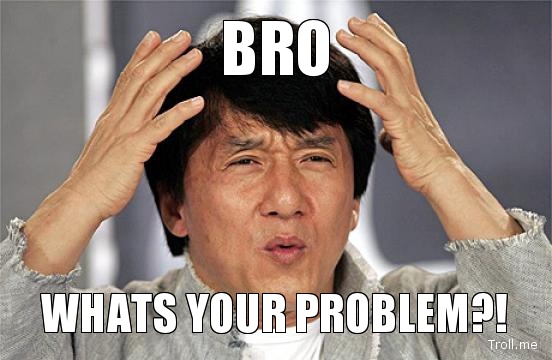
Well let’s start with this.
We’re guessing we’re gonna win this one. But then again, this is an online site, so DUH obviously you read online.
Let’s go a bit deeper.
In Bernama TV‘s case, it seems it has nothing much to do with trends, but that it’s just a company with serious problems even since last year. Astro actually recorded stronger earnings than ever! In other news, apparently “Reading the Paper” is one of the most common activities in Malaysia according to GFK.
“Around 82 percent of respondents from Malaysia read newspapers on a weekly basis as compared to the Asia Pacific average of only 62 percent, and an even lower global average of 59 percent. In fact, listening to music is the most popular activity of global consumers, where an average of 76 percent said they do it weekly or more, followed by shopping for groceries (70%) then reading newspaper (59%).” – Selinna Chin, Managing Director, GfK Malaysia.
Hmmm… wonder how “surfing the internet” figures into those stats. Strangely, it seems there’s no mention of internet activities in that market, which of course, didn’t stop The Star from publishing this as a result.
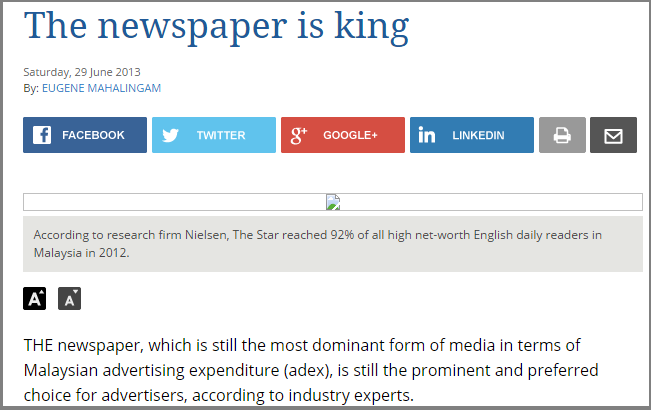
Please read it. Cos it’s quite funny 🙂
How about Magazines? Well here are some print run stats from the Audit Bureau of Malaysia.
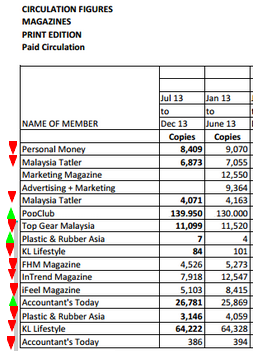
 Yep. Circulations are going down, and as a former editor of a men’s magazine called NewMan and a gadget mag called STUFF (which is now closed in Malaysia!), I can tell you that I’m not surprised (in fact, we’re surprised they’re that high!). Neither are some of my peers. This is what the ex-editor of Clive, a mostly-print men’s magazine, had to say.
Yep. Circulations are going down, and as a former editor of a men’s magazine called NewMan and a gadget mag called STUFF (which is now closed in Malaysia!), I can tell you that I’m not surprised (in fact, we’re surprised they’re that high!). Neither are some of my peers. This is what the ex-editor of Clive, a mostly-print men’s magazine, had to say.
“Clive wasn’t making a loss, but it was far from being a mad money maker – but the title did serve as a ‘deal sweetener’, as in sales would package exposure in this magazine as part of any media sale for Juice or Stuff. So suppose it wasn’t a difficult decision by the powers that be to can the title.” – Ellfian Rahim, Editor, Clive.
And Erna Mahyuni, who has been with several media over the years, but is currently MalayMailOnline’s hard-hitting columnist.
“Print won’t die yet – but it has to work harder, build complementary web presences.” – Erna Mahyuni, Columnist, MalayMailOnline.
And Reta Lee, a contract editor.
“With the insurgence of new websites whether news or entertainment, users are spoilt for choices as with the use of their gadgets like tablets and smartphones… They’re consuming content online instead of traditional media like magazines and papers.” – Reta Lee, Contract Editor
One of the ex-Yahoo! peeps however, had an interesting point. Chee Seng is now a freelance writer, and was actually CILISOS’ most successful freelancer to date with his article about Malaysian Supervillains. That one article alone got 150,000 views.
“People think it’s the shift to the internet, but the question is “why are people shifting to the internet”? The internet is nothing but a system of connections.
It’s the ‘content’ on the internet that people find more interesting. So, as print media chases the market to the internet by setting up online versions, naturally print will continue to die. There’s just no more incentive to buy a print copy when you can read online, right? – Chee Seng, Yahoo! Ronin
But with broadband penetration in Malaysia reaching 67%, it’s clear that online represents a pretty significant portion of Malaysian eyeball time. Even Google says that Malaysia has one of the highest smartphone penetration rates in the world. But then, as demonstrated above, anyone can find suitable statistics to prove their point.
Having said that, internet advertising is a fairly new thing for Malaysian advertisers (the industry only really started around 2005-2006 here).
You won’t believe how little Malaysian advertisers are spending on digital
Here’s a chart we found on ecommercemilo.com referring a study done by Aegis Global Advertising Expenditure Report. Strangely, it was difficult to source an exact breakdown of ad-spend in Malaysia so this is what we could find. If you have a better source, let us know in the comments below.
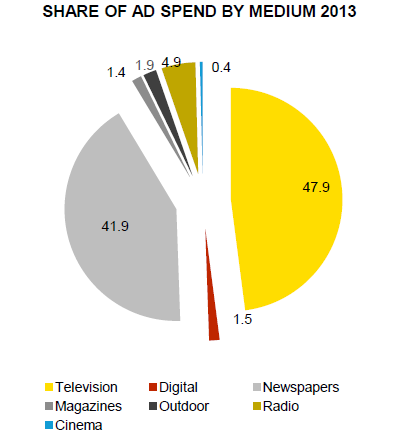
“Even though Newspaper is losing ad market share, it is still commanding a huge RM 3.78 billion in 2013 out of the total RM 9 billion advertising expenditure.” – ecommercemilo.com
Amazingly, even last year, Digital only accounted for 1.5% of the whole industry’s ad spend (pg 116). Wait.
No wonder even websites are closing down. To be fair, when we told some of our interviewees these figures, they told us the digital figures might be made smaller for a few reasons.
- Facebook and Google do not disclose their earnings – It’s tracked somehow in the report, but it might not be accurate.
- Traditional media spend might be inflated
- The tracking is off lor.
Other countries numbers in the report seem to show up ok as well, with Singapore at 29%(pg126) and Indonesia at 34.8% (pg111)! Industry leaders we spoke to put the actual number at anywhere between 5%-10% (which still isn’t much), but we couldn’t find a figure online to match that. From industry sources, we know that for every telco that spends 15-20% of its budget to online, there are brands that still don’t spend anything in that space. Maybe it’s cos Malaysians outside of rural areas are still watching TV and reading papers?
“Malaysian marketers would find few excuses here either. According to Mindshare data, on a daily basis, Malaysians spend 1.3 hours watching TV, 0.6 hours listening to the radio, and 0.3 hours reading newspapers or magazines.
They however spend 2.8 hours a day on their mobile, 2.7 hours on their PC or laptop, and one hour on their tablet. Malaysia stands out as a multi-device, mobile-centric country.” A. Asohan, ‘The digital/ mobile revolution: Malaysian marketers are laggards’, from our friends at Digital News Asia
THEN?! Why so little money for Internetz!?
Sorry… do we sound a bit emotional?
OK, you might say Print has more prestige, or that Radio has a more captive audience, or the most regularly used one – No one clicks on banner ads anymore. To that, we say this.
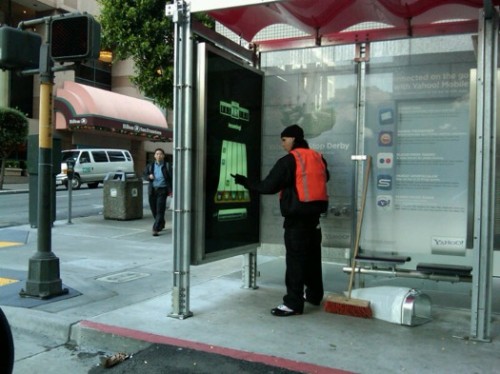
Paul Tan, who owns Malaysia’s top automotive blog by some margin earns about RM4 million annually from 1.5 million users (in Malaysia, and another 300k from abroad).
“We don’t think it’s fair, what online mediums like ours earn in comparison to traditional. Just look at Motortrader classifieds generating over RM20 mil. You think Mudah.my, Carlist.my or Oto.my get anywhere close to that? And when’s the last time you heard someone sold their car through Motortrader magazine. But used car dealers would gladly pay crazy money for an ad there. We work so much harder for our revenue, somemore every single thing must be justified.” – Paul Tan, founder (duh) of Paultan.org
Rene Menezes, of premium ad reseller, Better Digital has similar thoughts.
“I believe the (digital % of total adspend) is closer to 8% to 10% with many clients already spending close to half online and many more spending nothing at all. Even with low spends in general, the big spenders who do 30% to 50% of their budgets online make a healthy base for us and having worked with them for close to decade, we can rely on their spending as a foundation as long as we keep giving them results and value.
Yes, they do demand more by way of yield and ROI and also risk free pricing models like cost per sale etc. But that’s the way it should be, which is why I’m not complaining. The point is they should demand the same of all other media or don’t demand at all.” – Rene Menezes, CEO, Better Digital Solutions
At the end of the day, any justification you put forward cannot justify the very, very low amounts of money being spent online in Malaysia. Some of our interviews higlighted figures to be released this year putting that figure at 4-5%, which is decent, but still lagging behind the US at 28.2%, the UK at just under 50%, and even Singapore, which is projected to be as high as 67% by 2016.
So what? A lot of websites around what… can survive right?
On good sources, here’s what we found out. An owner of a top 20 website in Malaysia with almost 4 million unique visitors told us they earn up to RM400,000 a month. Compare that to The Star, which has a reach of 1 million (they actually sell about 300,000 papers a day, but claim each paper is read by 3-4 people). The Star newspaper alone make RM70 million a month.
“So Malaysian website earns 13 sen per user, while Malaysian newspaper earns RM70 per user.” – MAT MATIK
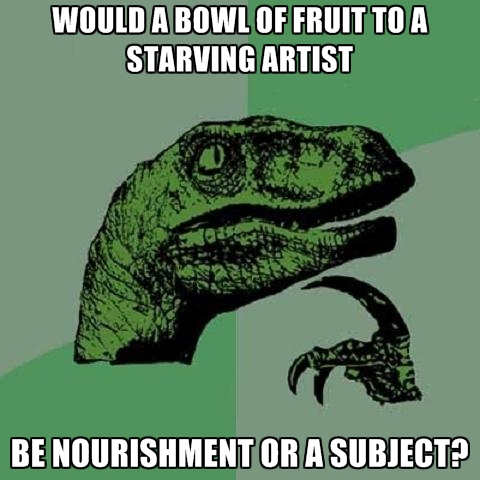 When CILISOS started getting some decent traction around June, attracting some 200,000 visitors a month, we asked a few banner aggregators (these are the guys that sell banner inventory from multiple websites) how much a site with our traffic can earn from impression ads. And we were told – RM1,000-1,500. OMFG. Pay for one writer also kenot. In fact, this blogger complained about similar things with NuffNang, who paid him a grand total of RM2.75 for 10,000 views. It’s not entirely NuffNang’s fault, cos that’s what the industry is paying.
When CILISOS started getting some decent traction around June, attracting some 200,000 visitors a month, we asked a few banner aggregators (these are the guys that sell banner inventory from multiple websites) how much a site with our traffic can earn from impression ads. And we were told – RM1,000-1,500. OMFG. Pay for one writer also kenot. In fact, this blogger complained about similar things with NuffNang, who paid him a grand total of RM2.75 for 10,000 views. It’s not entirely NuffNang’s fault, cos that’s what the industry is paying.
Compare that reach to any magazine, TV broadcast, or Radio Station, and you’ll see that for some strange reason, the Malaysian internet is really getting shafted in terms of revenue. Sure, you can argue, hosting doesn’t cost much and neither does generating web content. But you know what does? Good people.
“I guess the more important question to ask is this, are media owners saviours of journalism or are they just a bunch of businessmen? Does the public actually know how much it costs to run a publishing house?
Do you know how many twats like Soscili are out there now searching for advertiser dollars? It’s become a numbers game. “I got more pageviews, I got more ‘likes’. Advertise with us!”
Hey, f**k your ‘likes’! You get ‘likes’ these days with what is borderline-plagiarism. Slap on a stupid headline, it goes ‘viral’. All this talk of change is redundant. For now, JUICE is the one true God until the pulp runs out” – Ben Liew, Editorial Director, Rev Asia
Yep, websites don’t just survive on rainbows and unicorns. Right now, because of the shortfall of revenue to traffic, websites are DESPERATE for traffic. After we covered what The Rakyat Post did to us, numerous journalists sent us notes, telling us that online sites rip each others stories off all the time, all in the pursuit of higher traffic numbers to drive higher ad-revenues. We get plagiarised almost every week. Also, even respectable publications need to use purposefully sensationalist headlines to buy more eyeballs.
Notice how everyone is using listicles these days? Not that there’s anything wrong with them, of course 🙂 In the pursuit of traffic, we have heard from journalists (off-record) that there are even certain news organisations that insist on having at least 4 SEX related stories everyday.
Yes, we’re also sometimes sensationalist (notice how we’re harping on that 1.5%… heh).
Cari makan ma.
Then how?! Make CILISOS newspaper lo

But then right… we would probably get less readers (but hopefully more money). And at the end of the day, that’s not what we’re here for. We want to educate a wider audience – the advertising is to pay our bills, cos no one works for free. Unfortunately, in our desperation to share the measly chunk of the market, sometimes even we lose our bearings and go for the big-views sensationalist stuff, or sometimes literally selling bekside to get ads, as many Malaysian bloggers have talked about before.
“Readers come to a portal to read about the writer’s opinions about topics. Too many advertorials will make your site less interesting and thus the loss of traffic. If traffic is not high enough, then the site isn’t prominent enough for a client’s investment. ” – Eddy Han, Vice President, Lowyat.net
You can call it by its new name, Native Advertising… whatevs, but at CILISOS, we have very different ways of doing sponsored content, primarily using user-generated content as our main sell, and the ability to craft and curate it as our way of adding value. And yes, our advertisers are very happy (so far… touch wood) with it.
But the budgets are still limited (people just generally demand more and pay less for online), and people still ask for discounts, which in the end, leaves sites like ours struggling to make a decent living. Isn’t it weird that Newspapers and TV don’t seem to be having that issue, while the #1 medium where you, dear reader, spend most of your time, is struggling to make ends meet?
At the end of the day, it’s the readers that lose out. Because they can’t get the content they want on the medium they frequent the most.
We at CILISOS believe that the current lack of funds flowing online has been very unhealthy for the online industry itself. And the solution is not to switch ourselves to Print or TV, but rather to make the best of the industry we’re in.
But we can’t do it ourselves.

So we call on you, dear fans – Especially those in advertising and media. If you enjoy the things you read online, and you know they give you so much more utility than what you get from magazines, or from TV or from radio, then let your clients know. Or at least, share this article. We’re not asking for 50% or even 40%, but perhaps a better indication of where yo’ eyeballs at.
Also, for regular users, try paying for content. Subscribe to Spotify (yes, I just did from peer pressure), buy that game on Steam, subscribe to Malaysiakini. Cos when someone else pays for your content, you get what they pay for.
To our fellow competitors – As long as the online industry continues to sell itself short, we’re never going to get any better. So what we’d like to do now is to start an online guild of websites.
Perhaps the Malaysian Digital Association can look at this? Let’s collectively set new rates that reflect the eyeballs we’re actually worth. If anyone’s interested in this, then send me an email and let’s grow this space.
- 564Shares
- Facebook542
- LinkedIn1
- WhatsApp1


